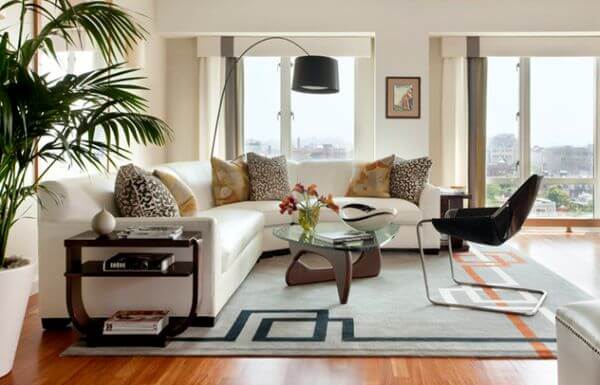Tiny homes and minimalist living are quickly gaining steam in the housing market. However, most prefabricated tiny homes don’t appear small because of smart interior design that creates the illusion of space.
Whether you’re in a tiny home, apartment, or one storey abode designed by Vision One Homes, using your interior design savvy to make your home look bigger than it is can add comfort and storage to your living space with minimal time and cost. Here are a five ways to make that happen:
Hang Curtains Above the Window
Rather than hanging your curtains along the window frame, install the curtain rod about six inches above, or as close to the ceiling as possible without making the curtains appear to be misplaced. Then, use long curtains that hang to the floor. This creates a sense of larger windows and higher ceilings than you actually have.
You’ll want to measure the length before purchasing curtains, as having curtains that are too short ruins the effect and looks clumsy. Having curtains that are too long, on the other hand, end up bunching on the floor and look bulky and messy.
Use Light Colors for Walls and Flooring
Using dark colors on walls and flooring adds an elegant, moody atmosphere to your rooms. However, the dark paint absorbs light rather than reflecting it and can make a room appear smaller than it is. When choosing colors for walls and flooring, it’s best to stick with light, bright options or neutrals.
If you want to incorporate dark colors into your decor, use darker curtains, rugs, furniture, and art as a way to balance the brightness. This is also a useful way to add color if you are in a rental space that doesn’t allow you to paint over their pristine, white walls.
Add Lots of Mirrors
As with light paint, mirrors reflect light around the room. Additionally, they give the illusion of making a room seem larger as the eyes are drawn into the extension of the room offered by the mirror. Mirrors can be used in place of artwork in living rooms, and on sliding closet doors in bedrooms.
Large, ornate mirrors can be costly and difficult to transport. A budget option for incorporating mirrors into your decor is to purchase a cheap, frameless mirror from a department store and create your own frame on the wall using stained trim to match your furniture. Alternatively, group lots of small, mismatched mirrors together in the same area for a whimsical vibe.
Strategic Furniture Arrangement
Sometimes something as simple as changing how your furniture is arranged can make a room seem bigger, either by creating a visual illusion or by maximizing available space. Simple ideas like prioritizing larger items or identifying focal points and building the room around them can make a significant impact. Allowing adequate space for walking paths and moving around furniture is also a great way to improve a room’s flow.
A commonly used interior design trick is to float your furniture. That is, to create space between a couch or bed and the wall behind, rather than pushing the item flush against the wall. In a living room, you can use this space to incorporate a flat surface that isn’t visible while looking at a couch. The surface can replace the need for bulky end tables or coffee tables.
Ditch the Overhead Lights
Traditional overhead lighting, particularly pot lights, only cast light on a small area with very defined borders between the light and shadows. Casting shadows creates a feeling of a small, darker space that counteracts your light reflecting efforts. Floor lighting and table lamps create a more ambient glow that lights a larger area.
If you feel as though overhead lights are a must, look at fixtures that hold multiple bulbs without bulky coverings. Clear glass shades and track lighting are a few ways to make ceiling lights work in your favor and can work well with lamps and sconces to make your room glow pleasantly.
With these decor tips, you can find a healthy balance between cozy and spacious to make your house feel like home.






